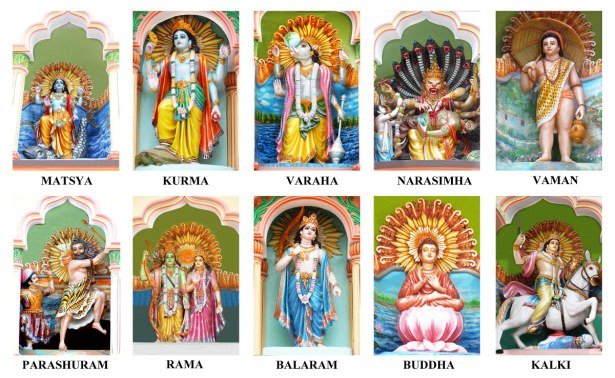
Dashavatara (also spelled Dashavatar) is a collective noun used for the 10 avatars (incarnations) of Lord Vishnu on the Earth. ‘Dasha’ means ten and ‘Avatara’ means incarnation. The 4 of them took place in the Satya Yuga, 3 in Treta Yuga, 1 in Dvapara Yuga, 1 in Kali Yuga and 1 is yet to take place in Kali Yuga. There are believed to be a total of 24 Avatars of Lord Vishnu, but these 10 are principal incarnations and are more popular than others.
The 10 Avatars of Lord Vishnu (Dashavatara):
1. Matsya:
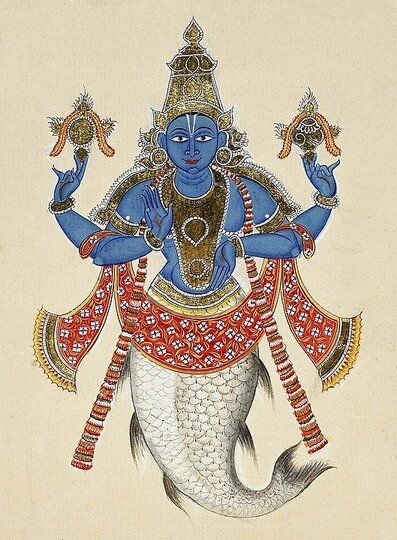
This is the first incarnation of Lord Vishnu. It happened in the Satya Yuga. In this Avatara, Lord Vishnu appeared in a part-fish and part-man form and saved Manu and seven sages along with other species of animals from the Great Deluge.
2. Kurma:
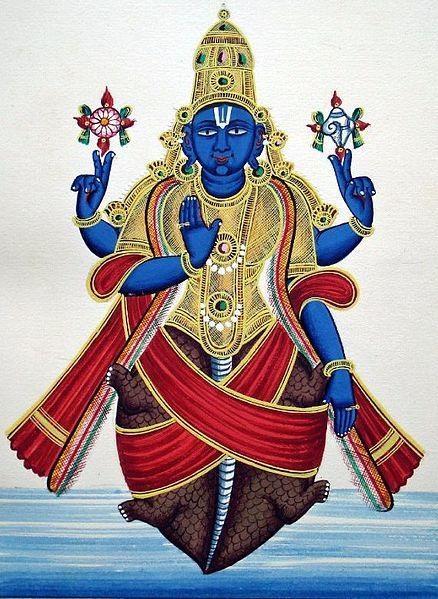
Kurmavatara (Kurma means a turtle) means incarnation of Lord Vishnu as a turtle. It was the second incarnation of Lord Vishnu. In this incarnation, Lord Vishnu helped gods and demons to churn the milky sea and take out the nectar. Lord Vishnu further made sure that demons did not get the nectar.
3. Varaha:
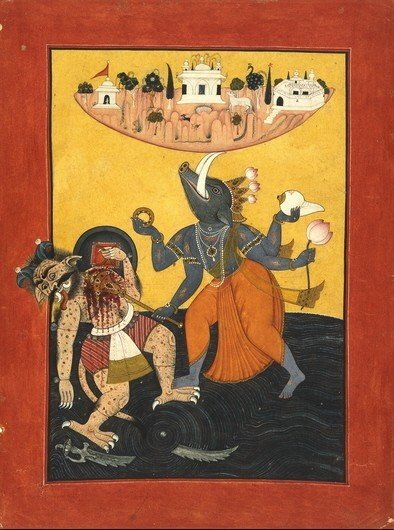
Lord Vishnu incarnated as a half boar and half man. He killed a demon Hiranyaksha who had taken the earth at the bottom of a cosmic sea and restored the Earth in its place. This avatar took place in Satya Yuga.
4. Narasimha:
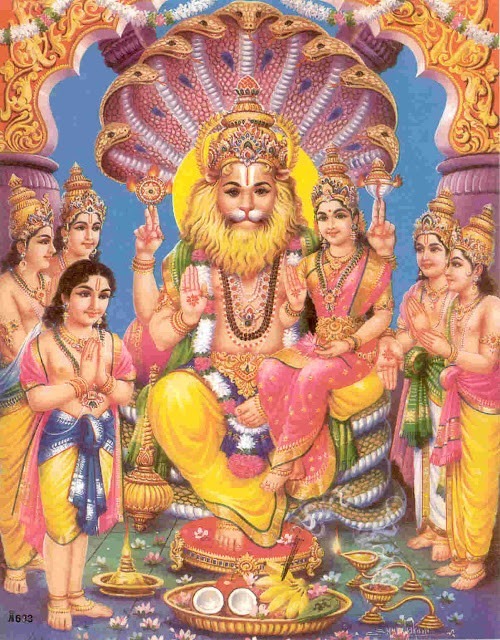
Narasimha Avatar (Nara means “man” and Simha means “lion”) was the fourth incarnation of Lord Vishnu in the form of a part-man and part-lion who killed the despotic demon king Hiranyakashipu and restored dharma on the Earth. This incarnation happened in Satya Yuga.
5. Vamana:

Vamana (means dwarf) Avatar was the fifth incarnation of Lord Vishnu that took place in the Treta Yuga. He was the first incarnation of Vishnu as a human being. He took back the kingdom of gods from Asura king Bali and gave it back to the king of demi-Gods, Indra.
6. Parashurama:
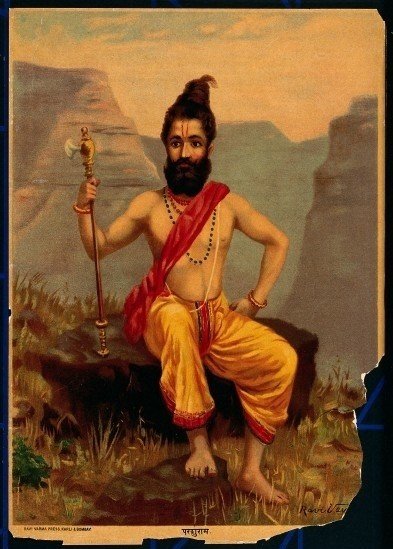
Parshuram, the Brahmin warrior, is the sixth incarnation of Lord Vishnu. He is one of the eight immortals of Hindu mythology. He is a Brahmin who turned into a warrior after the murder of his parents by Kshatriyas. Lord Parashurama got a divine ax from Lord Shiva to kill Kshatriyas who had forgotten their dharma. It took place in the Treta Yuga.
7. Rama:
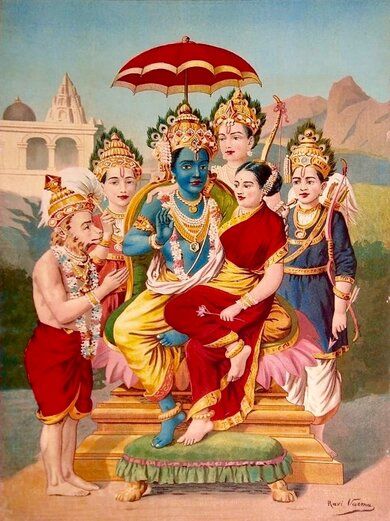
Lord Rama was the seventh incarnation of Narayana. He was the prince of Ayodhya who later became a king. He killed the demon king Ravana who abducted his wife Sita and freed many human beings captive. It took place in the Treta Yuga.
8. Lord Krishna:

Lord Krishna was the eighth incarnation of Lord Vishnu. He killed many demons and guided Pandavas to kill the evil Duryodhana and his forces. He also narrated Bhagavadgita to Arjuna which is a major book of Hindus. It took place in the Dvapara Yuga.
9. Buddha.
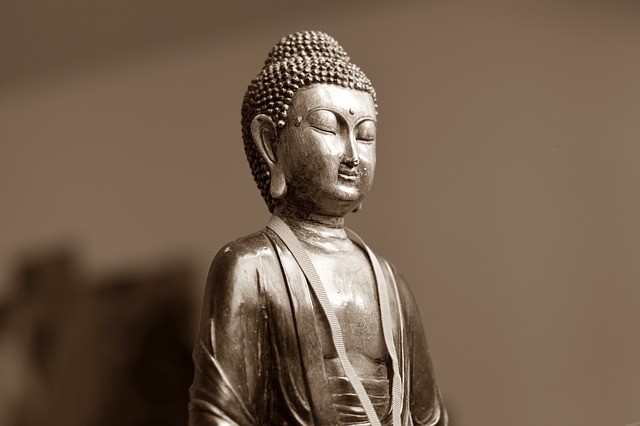
As per Hinduism, Gautama Buddha is the ninth incarnation of Lord Vishnu. This avatar took place in Kali Yuga. He spread the message of peace through Buddhism.
OR
9. Balarama:
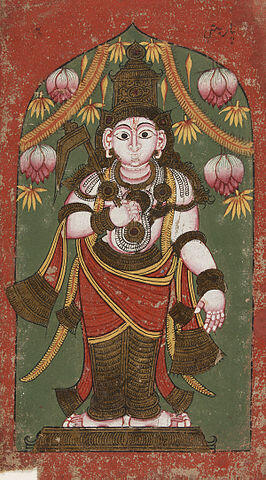
Many Vaishnavites believe that Balarama was the ninth Avatar of Lord Vishnu and not Lord Buddha, but commonly, he is believed to be an incarnation of Sheshanaga. Lord Balarama was the elder brother of Lord Krishna. He helped him kill Kamsa and many other demons. His weapon was a divine plow and is the god of agriculture and strength.
10. Kalki:
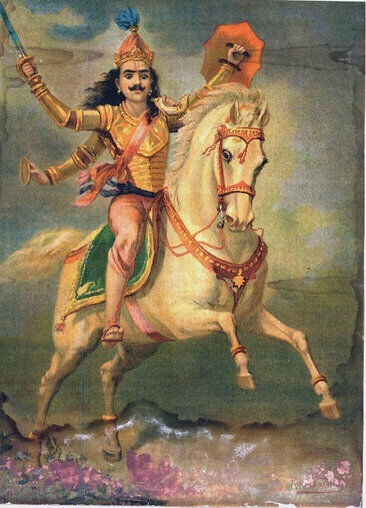
Kalki Avatar will be the tenth and final incarnation of Lord Vishnu. He would free Earth of all the sinners and restore Dharma. It is prophecized that he would be born in Sambhala village in a Brahmin family at the end of Kali Yuga.
Why Does Lord Vishnu Incarnate on Earth:
1. To Protect Dharma in Difficult Times.
Hinduism has three main deities, viz. Lord Brahma (the creator), Lord Vishnu (the protector), and Lord Shiva (the destroyer). As Lord Vishnu’s role is to protect the universe, whenever the evil forces become stronger than the good forces and there is a need to restore dharma (righteousness), Lord Vishnu incarnates and eradicates the evil forces and restores dharma.
In Bhagvad Gita, Lord Krishna says:
यदा यदा हि धर्मस्य ग्लानिर्भवति भारत|
अभ्युत्थानंधर्मस्य तदात्मानं स्रुजाम्यहम्|
परित्राणाय साधूनां विनाशाय च दुष्कृताम्|
धर्मसंस्थापनार्थाय सम्भवामि युगे युगे|
Yada yada hi dharmasya glanirbhavati bharata|
Abhutthanamadharmasya tadatmanam srijamyaham|
Paritranaya sadhunaam vinashay cha dushkritam|
Dharmasansthapanarthay sambhavami yuge yuge|
Whenever there is a decay of righteousness, O Bharata,
And there is an exaltation of unrighteousness, then I descend myself,
For the protection of the good, for the destruction of evil-doers,
For the sake of firmly establishing righteousness, I am born from age to age.
2. Because of the Curse of Sage Bhrigu.
When gods attacked Asuras, they took refuge at Sage Bhrigu’s hermitage. The wife of the sage, Kavyamata, built an impenetrable shield around the hermitage. To break the shield, Lord Vishnu used his Sudarshan Chakra. He successfully destroyed it but in the process, Kavyamata was also killed. Sage Bhrigu got angry with Lord Vishnu and cursed him that he would have to take countless avatars on Earth and suffer most pain and confinement due to his sin of woman-slaughter.
3. To Kill the Despotic Asuras:
Most of the avatars of Lord Vishnu are in some way associated with Asuras. Lord Vishnu not only protects humans but also helps gods by winning heaven back from Asuras. Killing evil Asuras is also one of his duties.
4. To Protect the Earth:
Per Hinduism, Earth is a goddess and an incarnation of Goddess Lakshmi. If the existence of Earth is at stake, then also he incarnates and protects her.
According to the Vishnu Purana, this has happened nine times so far and will happen the tenth time in this Yuga, i.e., the Kali Yuga (the dark age).
Controversies Related to Dashavatara:
The main controversy related to Dashavatara is about Lord Buddha. Some Buddhist scholars do not believe in Lord Buddha as the ninth incarnation of Lord Vishnu. They say it was a trick played by Brahmins to decrease the influence of Buddhism when Buddhism was at its peak in India. Some Vaishnavites also do not believe Buddha is the incarnation of Vishnu. Instead, they believe Balarama as the 8th and Krishna as the 9th incarnation of Vishnu. But generally, Balrama is considered an incarnation of Shesha which sounds more logical because, in the Ramayana, Lakshmana was the incarnation of Shesha. Anyway, these are the 10 widely accepted incarnations of Lord Vishnu in the Hindu world.
Dashavatara Stotra:
It was written by Jayadeva and is a part of Geeta Govinda.
प्रलयपयोधिजले धृतवानसि वेदम । विहितवहित्रचरित्रम खेदम ।
केशव धृतमीनशरीर जय जगदीश हरे ।।1।।
क्षितिरतिविपुलतरे तव तिष्ठति पृष्ठे । धरणिधरणकिणचक्रगरिष्ठे ।
केशव धृतकच्छपरुप जय जगदीश हरे ।।2।।
वसति दशनशिखरे धरणी तव लग्ना । शशिनि कलंकलेव निमग्ना ।
केशव धृतसूकररूप जय जगदीश हरे ।।3।।
तव करकमलवरे नखमद्भुतश्रृंगम । दलितहिरण्यकशिपुतनुभृगंम ।
केशव धृतनरहरिरूप जय जगदीश हरे ।।4।।
छलयसि विक्रमणे बलिमद्भुतवामन । पदनखनीरजनितजनपावन ।
केशव धृतवामनरुप जय जगदीश हरे ।।5।।
क्षत्रिययरुधिरमये जगदपगतपापम । सनपयसि पयसि शमितभवतापम ।
केशव धृतभृगुपतिरूप जय जगदीश हरे ।।6।।
वितरसि दिक्षु रणे दिक्पतिकमनीयम । दशमुखमौलिबलिं रमणीयम ।
केशव धृतरघुपतिवेष जय जगदीश हरे ।।7।।
वहसि वपुषे विशदे वसनं जलदाभम । हलहतिभीतिमिलितयमुनाभम ।
केशव धृतहलधररूप जय जगदीश हरे ।।8।।
निन्दसि यज्ञविधेरहह श्रुतिजातम । सदयहृदयदर्शितपशुघातम ।
केशव धृतबुद्धशरीर जय जगदीश हरे ।।9।।
म्लेच्छनिवहनिधने कलयसि करवालम । धूमकेतुमिव किमपि करालम ।
केशव धृतकल्किशरीर जय जगदीश हरे ।।10।।
श्रीजयदेवकवेरिदमुदितमुदारम । श्रृणु सुखदं शुभदं भवसारम ।
केशव धृतदशविधरूप जय जगदीश हरे ।।11।।
Dashavatara and Evolution:
It is interesting to know that there is some correlation between the 10 incarnations of Vishnu and the theory of evolution. Though it is not 100% accurate, it has some relation with evolution, especially the order in which they appear is really surprising. They do correlate with the modern theory of evolution to some extent.
1. Matsya (Fish) – Animals in the water like fish are born.
2. Kurma (Tortoise ) – Animals who can live both on land and in water are born.
3. Varaha (Boar) – Herbivorous animals are born.
4. Narasimha (Lion) – Carnivorous animals are born.
5. Vamana (Dwarf) – Dwarf people are born.
6. Parashuram (Man with an ax) – People started using iron (iron age).
7. Rama (Man with bow and arrow) – People developed skills using semi-modern weapons like bow and arrow.
8. Krishna (Clever man with Sudarshan Chakra) – People became shrewd and started using more advanced weapons (heralding Kali Yuga).
9. Buddha (who has attended wisdom) – People became clever and started advancing to the modern age.
10. Kalki – Very advanced human beings, both technologically and genetically.
The Pattern of Dashavatara:
If you see closely, you would find that there is a pattern in the 10 incarnations of Lord Vishnu. The four avatars happened in Satya Yuga, three in Treta Yuga, two in Dvapara Yuga (if we assume Balarama is an avatar of Lord Vishnu), and one would happen in Kali Yuga. The number of incarnations has decreased by one in each Yuga. Also, the first four incarnations are associated with animals (part-animal, part-human), but the later incarnations are completely human.
In the Puranas, the cow is compared to dharma and it is said that the cow of dharma stands on four legs in Satya Yuga, three in Treta Yuga, and two in Dvapara Yuga, and on only one leg in Kali Yuga. So it seems the incarnations of Lord Vishnu are symbolized as the legs of the cow of dharma.
When Lord Vishnu Incarnates, Does He Himself Come on the Earth, or are Dashavatara His Clones?
There are some contradictions in the scriptures about this. Some Puranas say that he himself comes to the Earth. But then how could two of his avatars be present on Earth at the same time? If we see in the Ramayana and Mahabharata, that Lord Parashurama was not only present but played an active role. Also, per the Bhavishya Purana when Kalki Avatar would come, Lord Parashurama would train him.
Lord Vishnu is lord of many universes. There could be millions of planets like Earth in different universes. So I think it is convenient for him to send his messengers everywhere rather than coming himself.
Therefore, most probably Dashavatara is his divine clones that carry a part of his soul and body in them.
Birth Places of the 10 Avatars of Lord Vishnu:
1. Matsya: In an open river.
2. Kurma: In the ocean of milk.
3. Varaha: Born from Brahma’s nose (so perhaps Brahma Loka).
4. Narasimha: From a pillar of a palace located currently in the Multan region of Pakistan.
5. Vamana: In a hermitage of Sage Kashyapa.
6. Parashurama: In the forest of Eastern Uttar Pradesh.
7. Rama: Ayodhya in Uttar Pradesh.
8. Krishna: Mathura in Uttar Pradesh.
9. Buddha: Lumbini in Nepal.
10. Kalki: Shambhala.
Wives of 10 Avatars of Lord Vishnu:
1. Matsya: Had no wife.
2. Kurma: Had no wife (Sindhu Suta per some sources).
3. Varaha: Bhu Devi.
4. Narasimha: Narsimhi.
5. Vamana: Kamala.
6. Parashurama: Commonly believed to have no wife (Dharani per some sources).
7. Rama: Goddess Sita.
8. Krishna: Rukhmini, Satyabhama, Jambavati, Nagnajiti, Kalindi, Mitravinda, Bhadra, and Madra.
9. Buddha: Yashodhara.
10. Kalki: Padma and Ramaa.
How did Dashavatara Disappear/Die?
There are different stories of how the 10 avatars of Lord Vishnu disappear/die.
1. Matsya: The Matysavatara merged into Lord Vishnu after he saved Manu.
2. Kurma: Merged into Lord Vishnu.
3. Varaha:
A. Merged into Lord Vishnu.
B. Per the Kalika Purana, Lord Vishnu requested Lord Shiva to kill Varaha and his three sons as they were causing trouble on the Earth. Therefore, Lord Shiva incarnated as Sharabha and killed them.
4. Narasimha:
A. Merged into Lord Vishnu.
B. Even after killing Hiranyakashipu, Narasimha’s rage did not mitigate. Gods feared that the universe would annihilate because of it. Therefore, Lord Shiva took the form of Sharabha and killed him.
5. Vamana: Merged into Lord Vishnu.
6. Parashurama: He is immortal and is still living in a subtle body.
7. Lord Rama: After the completion of his task on the Earth, he drowned himself in the Sharayu river per the request of the gods.
8. Lord Krishna: In his previous life, he had killed Vali by treachery. Therefore, he had promised him that he would die by his hands in his next birth. Vali incarnated as Jara shot a poisonous arrow at him mistaking sleeping Lord Krishna for a deer.
9. Buddha: He died from food poisoning.
10. Kalki: This avatar is yet to appear.
Movies:
1. An animated movie named ‘Dashavatar‘ has been made on the concept of Dashavatara in 2008.
2. Dasavatharam (2008) was another movie in which Kamal Haasan played 10 roles, but it was not based on the concept of Dashavatara.
You May Also Like To Read: Meaning and Concept of Avatar in Hinduism
Wonderful! Thank you so much for bringing these information forward to those which are still learning!
Thank you for all your efforts!